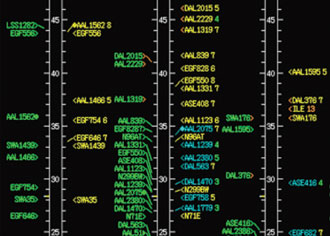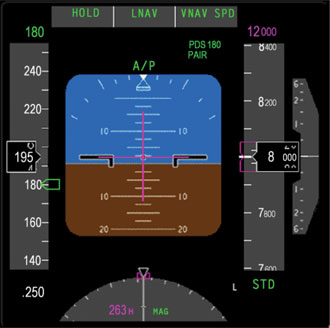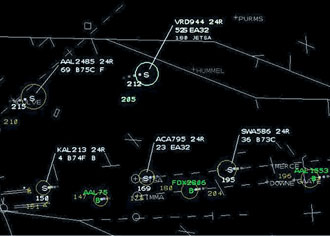|
|
 |

|
 |
 |
Interval Management - Terminal Area Precision Scheduling and Spacing (IM-TAPSS)
|

ATD-1 technologies will enable arrival aircraft to safely fly closer together on more fuel-efficient routes to increase capacity, reduce delay, and minimize emissions.
|
Today's National Airspace
At any given moment, up to 5,000 aircraft crowd U.S. skies. In 2010, the National Airspace System (NAS) managed the progress of nearly 10 million flights. Such high air traffic demand, operating with procedures that were largely in place from the earliest days of commercial aviation, does not always result in the most efficient or coordinated operations. As a result, the air transportation system often experiences significant delays and lost productivity, and produces greater amounts of noise pollution, carbon dioxide, and other greenhouse gas emissions than if operations were more efficient. As air traffic demand is projected to double in the next 20 years, our current air traffic control system will be further strained and the environment adversely affected.
Improving the efficiency of the terminal area, which is the volume of airspace surrounding airports to a radius of about 50 miles, is an especially complex task due to operating characteristics that are quite distinct from the en route environment. Terminal area controllers manage both ascending and descending aircraft, more frequent turns, a wider range of separation standards, as well as terrain and increased traffic density within shorter time horizons.
In today’s terminal area arrival operations, as an aircraft transitions for landing, controllers track and guide the aircraft from cruise altitude to the runway using simple visual aids as well as their skills and judgment. They issue turn-by-turn instructions (a process known as vectoring) via radio communications. As aircraft approach the runways, controllers manually merge aircraft and sequence them for arrival. Busy terminal area conditions often force the aircraft to fly inefficient arrival paths involving frequent changes in direction, altitude, and speed to maintain safe separation from other aircraft. Frequently, controllers must employ longer routes (known as path stretching) or holding patterns to tactically accommodate larger amounts of delay.
The tactical nature of this manual approach leads to increased fuel burn and noise pollution, contributes to high controller workload, and exacerbates traffic congestion. Moreover, the imprecision of this current system creates greater uncertainty, and forces controllers to add buffers to the separation required between aircraft, which decreases airspace capacity, leading to further delays.
While more efficient arrival paths are achievable today, current technology limits their feasibility to only during light traffic conditions, such as during the middle of the night. During periods of high-density traffic, maintaining safe separation and throughput take precedence over achieving efficient operations. The technical challenge facing the aviation community is to make efficient arrival procedures common practice during heavy traffic when they are needed most, while still ensuring safety and throughput.
NextGen: The Airspace System of the Future
NASA is collaborating with the FAA and other industry partners to develop several advanced automation tools that provide air traffic controllers, pilots, and other airspace users with more accurate real-time information about the nation’s traffic flow, weather, and routing. The greater precision of this information is a key enabler of the Next Generation Air Transportation System (referred to as NextGen). NextGen is a comprehensive transformation of the NAS, which will be safer, more reliable and more efficient, and will reduce the impact of aviation on the environment. The transition to NextGen is vital to improving system performance, meeting continued growth in air traffic, and increasing the Nation’s mobility to support economic progress.
ATM Technology Demonstration-1 (ATD-1) will showcase an integrated set of NextGen technologies that provide an efficient arrival solution for managing aircraft beginning from just prior to top-of-descent and continuing down to the runway.
These technologies are:
- Automatic Dependent Surveillance – Broadcast (ADS-B)
- Area Navigation (RNAV) Arrival Routes
- Optimized Profile Descent (OPD) Procedures
- Terminal Metering
- Flight Deck Interval Management (FIM)
- Controller Managed Spacing (CMS) tools
These ATM technologies have thus far been tested separately and each has demonstrated throughput, delay, and/or fuel-efficiency benefits. Together, the technologies will demonstrate the feasibility of high throughput of efficient arrival operations during peak traffic conditions in the terminal area. Simply put, the integration of these terminal arrival tools will allow arrival aircraft to safely fly closer together on more fuel-efficient routes to increase capacity, reduce delay, and minimize fuel burn, noise, and greenhouse gas emissions.
|

The Traffic Management Advisor (TMA) will determine an arrival schedule along advanced RNAV arrival routes for safe, orderly, and expeditious flow of traffic in the terminal area.
|
| Using the ATD-1 technologies, both pilots and controllers will have more accurate and timely information and advisories, thus reducing the need for extensive coordination and negotiation between them to achieve more efficient operations. Terminal Metering (based on precision scheduling enhancements to the Traffic Management Advisor [TMA]) will determine an arrival schedule based on airport conditions, airport capacity, required spacing, and weather conditions and utilize new, more direct RNAV routes that extend from en route airspace and continue through terminal airspace to the runway. The schedule, determined well in advance of when it is executed, will be communicated to both controllers and flight crews. Flight crews will know their intended flight path, which aircraft they ought to be following, and the desired spacing interval at certain points along their designated RNAV route to reach the destination airport safely and on schedule. Controllers will no longer have to make tactical, last second decisions concerning merges and arrival slots, and will not likely need to provide as many interventions as they do in today’s busy traffic conditions. |
| |

Flight Deck Interval Management (FIM) tools aboard the aircraft will enable flight crews to precisely space their aircraft relative to others to achieve ideal spacing.
|
To achieve the precise schedule set by TMA, some flight decks will be equipped with sophisticated onboard avionics. Flight Deck Interval Management (FIM) tools will provide guidance to pilots on whether to speed up or slow down to precisely merge and space their aircraft relative to others. The FIM tools will calculate speed advisories using information provided by ADS-B technology aboard the aircraft that is more accurate than traditional radar. Flight crews will be able to make finer adjustments to their speed and react more quickly to achieve ideal spacing. The tighter control enabled by FIM will reduce excess spacing buffers and result in higher terminal throughput.
NextGen will leverage the ADS-B infrastructure currently being implemented by the FAA. ADS-B uses a Global Positioning Satellite (GPS) System receiver aboard the aircraft to determine that aircraft's exact position. The ADS-B system combines the position data with the aircraft's identifier, course, speed, and altitude, then continuously broadcasts the information to other ADS-B equipped aircraft flying in the area. The information is also broadcast to a network of ADS-B ground stations, which in turn feed controller displays and other air traffic control technologies. ADS-B information provides greater situational awareness to flight crews and allows spacing responsibility to be shifted from the ground to the air, alleviating controller workload.
|
| |

Controller Managed Spacing (CMS) tools will provide controllers with the information needed to properly space all aircraft (including those not equipped with FIM) to meet terminal metering schedules.
|
For aircraft not equipped with FIM and ADS-B technologies in the mid-term, new Controller Managed Spacing (CMS) decision support tools will provide controllers with the information needed to properly space aircraft to meet terminal metering schedules created by TMA. CMS display enhancements will indicate to the controller where an aircraft is scheduled to be along its RNAV route, and will calculate the speed advisories needed to maintain this schedule.
Optimized Profile Descent (OPD) Procedures allow aircraft to fly a continuous, gliding descent at low engine power. Contrary to today’s typical "dive and drive" procedures in which aircraft fly powered constant-altitude segments in a step-down fashion, OPDs are considered "green descents" because they reduce fuel consumption, environmental emissions, and noise pollution. Decision support tools will synchronize the descents of all arrival aircraft and advise controllers of the RNAV route and speed profile needed so that each can maintain an efficient descent and remain properly separated from preceding and following aircraft. OPD enhancements will make green descents possible during more traffic conditions, even heavy congestion, all while satisfying terminal metering schedules and achieving precise in-trail spacing to maximize terminal throughput. |
| |

The higher precision achieved by ATD-1 technologies will reduce the size of excess spacing buffers, resulting in higher terminal throughput and capacity.
|
The more orderly, precise, and direct traffic flow enabled by the ATD-1 technologies will make the National Airspace System more predictable overall. This will allow airspace users to better respond to unexpected delays caused by convective weather and other airspace constraints. Instead of tactically absorbing delay close to the airport, where it is traditionally handled using path stretching and holding patterns, subtle variations in speed will be applied from cruise altitude to landing to distribute small amounts of delay over a longer portion of the flight. Strategically absorbing delay in this way relieves congestion that would normally build up near the airport, further increasing the efficiency of terminal area traffic flows.
Next Steps to Achieving NextGen
ADS-B will serve as the future surveillance source for the NAS. To further the widespread implementation of ADS-B, the Aviation Rulemaking Committee has recommended that demonstrations, such as ATD-1, should be used to help both the government and industry evaluate potential benefits and costs of such implementation, as well as to understand the necessary equipment standards, aircraft certification guidance, and operational approvals. NASA is teaming with the FAA and other industry partners to demonstrate the capabilities of integrated terminal area scheduling with an operational field trial in the 2014-2015 timeframe. The goals of the field demonstration will be to validate the benefits of the terminal area integrated arrival solution, system interoperability, and requirements for technology transfer.
The first phase of demonstration activities will involve development of prototype systems, integration of all of the technologies, and initial human-in-the-loop simulations in NASA laboratories. The next phase will involve development of the demonstration systems, follow-on simulations using FAA facilities and personnel, flight testing of avionics, and shadow testing of the integrated system. The last phase will finalize the demonstration plans and culminate in a field trial in a controlled, yet realistic operational environment at a major U.S. airport.
ATD-1 will be a truly collaborative endeavor between government and industry. It will involve the support, cooperation, and financial commitment of NASA and the FAA, as well as key industry and commercial aviation partners. NASA foundational research and technologies in terminal area scheduling, controller decision support tools, and flight deck automation will actively leverage the FAA's NextGen infrastructure. The participation of airspace users, avionics and aircraft manufacturers, and system integrators will enable these integrated terminal area ATM technologies to be evaluated in an operational environment. The demonstration is the next major step in NASA's NextGen research and development process, and it will bring us one step closer to realizing the air transportation system of the future.
For more information on ATM Technology Demonstration-1, please visit http://www.aviationsystems.arc.nasa.gov. |
| |
Benefits of ATD-1's Integrated Terminal Area Scheduling Technologies:
- System Benefits
- More efficient handling of delay
- Reduced excess spacing buffers
- Increased throughput
- More orderly flow of terminal area traffic
- Better predictability
- Decreased controller workload
- User Benefits
- Fewer delays
- Greater fuel-efficiency
- Increased use of advanced RNAV arrival procedures
- Environmental Benefits
- Fewer greenhouse gas emissions
- Less noise pollution
- Economic Benefits
- Increased mobility to support economic progress
|
Points of Contact: Todd Callantine, Ph.D., San Jose State University, Human Systems Integration Division, NASA Ames Research Center; Joey Mercer, M.S., Human Systems Integration Division, NASA Ames Research Center |
|
|